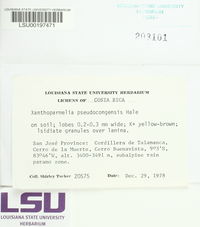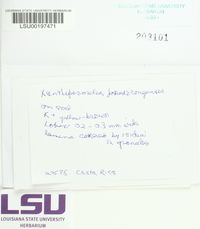
Consortium of Lichen Herbaria
- building a Global Consortium of Bryophytes and Lichens as keystones of cryptobiotic communities -
- Home
- Search
- Images
- Species Checklists
- US States: O-Z >
- US National Parks
- Central America
- South America
- US National Parks
- Southern Subpolar Region
|
|
|
|
Family: Parmeliaceae
|
Nash, T.H., Ryan, B.D., Gries, C., Bungartz, F., (eds.) 2004. Lichen Flora of the Greater Sonoran Desert Region. Vol 2. Thallus: foliose to subcrustose, tightly adnate, 2-6 cm in diam., dichotomously lobate lobes: sublinear, short, plane to subconvex, contiguous to imbricate, 0.3-0.8 mm wide, becoming lobulate marginally with age; lobulae: dichotomously branched, 0.2-0.4 mm wide; main apices: subtruncate, black rimmed, smooth to crenate, eciliate upper surface: light yellow-green but darkening centrally, smooth, shiny, epruinose and emaculate, moderately isidiate isidia: cylindrical, unbranched, 0.04-0.09 mm in diam., up to 1 mm tall; tips: syncorticate, black; soralia and pustulae absent medulla: white, with continuous algal layer lower surface: black, plane, shiny, moderately rhizinate; rhizines: black, simple, 0.2-0.3 mm long Apothecia: rare, adnate, 1-2 mm in diam.; disc: cinnamon-brown to dark brown; margin: smooth, pruina absent asci: clavate, 8spored ascospores: hyaline, simple, ellipsoid, 8-9 x 5-6 µm Pycnidia: rare, sunken conidia: bifusiform, 4-5 x 0.5 µm Spot tests: upper cortex K+yellow to orange, C-, KC-, P+ orange; medulla K+ yellow becoming dark red, C-, KC-, P+ orange Secondary metabolites: upper cortex with usnic acid (major); medulla with stictic acid (major) and constictic, cryptostictic and norstictic acids (minor), peristictic acid (trace). Substrate and ecology: on acidic rocks, often in open, arid habitats World distribution: southern North America and South Africa Sonoran distribution: occasionally at lower to intermediate elevations in Arizona, Baja California Sur and Sonora. Note: Previously X. pseudocongensis was only known from South Africa (Hale 1990), but it is now recognized from Arkansas to the Sonoran region. This species has short, subtruncate, black-rimmed lobes and cylindrical, black tipped isidia whereas X. substenophylloides has elongate, pale-rimmed lobes and pale or brown tipped isidia. |
Powered by Symbiota
















